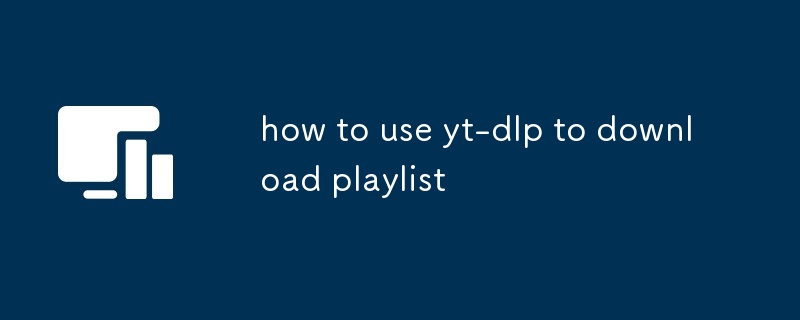Maison >Tutoriel logiciel >Logiciel >comment utiliser yt-dlp pour télécharger une playlist
comment utiliser yt-dlp pour télécharger une playlist
- DDDoriginal
- 2024-08-19 11:48:161231parcourir
yt-dlp, a command-line tool, enables efficient video and playlist downloads from various platforms, particularly YouTube. This article provides comprehensive instructions on installing and using yt-dlp to download playlists. It covers essential comma

How to Use yt-dlp to Download a Playlist
What is yt-dlp?
yt-dlp is a powerful command-line tool that allows you to download videos and playlists from various video-sharing platforms, including YouTube. It is a fork of the popular YouTube-dl utility, offering additional features, bug fixes, and improved performance.
How to Install yt-dlp?
- Check if you have Python installed on your system. If not, download and install Python from the official website.
-
Open your terminal and run the following command:
<code>pip install yt-dlp</code>
-
Verify the installation by running:
<code>yt-dlp --version</code>
How to Download a Playlist Using yt-dlp?
To download a playlist using yt-dlp, follow these steps:
- Open your terminal and navigate to the directory where you want to save the downloaded files.
-
Run the following command, replacing
[playlist-url]with the URL of the playlist you wish to download:<code>yt-dlp -x --audio-format mp3 --output "~/Music/%(playlist)s/%(title)s.%(ext)s" [playlist-url]</code>
- The
-xoption downloads only the audio streams of the videos in the playlist. - The
--audio-format mp3option specifies the desired output audio format. - The
--outputoption sets the output directory and filename template. You can customize the filename template to include metadata such as the playlist name and video title.
- The
- yt-dlp will start downloading the playlist. The downloaded audio files will be saved in the specified output directory.
Ce qui précède est le contenu détaillé de. pour plus d'informations, suivez d'autres articles connexes sur le site Web de PHP en chinois!
Articles Liés
Voir plus- Méthode de fonctionnement détaillée pour construire une image fonctionnelle du système de coordonnées polaires dans Geometry Sketchpad
- Comment désactiver le mode panorama sur Bilibili Tutoriel sur la désactivation du mode panorama sur Bilibili
- Comment définir l'affichage de la fréquence d'images dans le simulateur MuMu Tutoriel de réglage de la fréquence d'images de l'affichage du simulateur MuMu
- Comment exporter des images vectorielles dans coreldraw_Tutorial sur l'exportation d'images vectorielles dans coreldraw
- Comment vérifier la couleur dans le didacticiel coreldraw_coreldraw sur les couleurs d'épreuve

